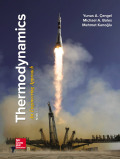
Air enters a cooling section at 97 kPa, 35°C, and 30 percent relative humidity at a rate of 6 m3/min, where it is cooled until the moisture in the air starts condensing. Determine (a) the temperature of the air at the exit and (b) the rate of heat transfer in the cooling section.
(a)
The temperature of the air at the exit.
Answer to Problem 130RP
The temperature of the air at the exit is
Explanation of Solution
As the process is a steady flow and thus the mass flow rate of dry air remains constant during the entire process.
Here, the mass flow rate of air at inlet is
The amount of moisture in the air remains constant as it flows through the heating section as process involves no dehumidification or humidification.
Here, specific humidity at state 1 and 2 is
Express initial partial pressure.
Here, relative humidity at state 1 is
Express initial humidity ratio.
Here, pressure at state 1 is
Express initial enthalpy.
Here, specific heat at constant pressure is
Express specific volume at state 1.
Here, gas constant of air is
As the air at the final state is saturated and the vapor pressure during the process will remain constant, thus the dew point temperature is the exit temperature.
Here, exit temperature is
Conclusion:
Refer Table A-4, “saturated water-temperature table”, and write the saturation pressure and initial specific enthalpy saturated vapor at temperature of
Substitute
Substitute
Substitute
Refer Table A-2, “ideal-gas specific heats of various common gases”, and write the properties of air.
Substitute
Substitute
Substitute
Refer Table A-5, “saturated water-pressure table”, and write the saturation temperature or exit temperature at pressure of
Write the formula of interpolation method of two variables.
Here, the variables denote by x and y is pressure and exit or saturation temperature respectively.
Show the specific enthalpy at state 2 corresponding to specific entropy as in Table (1).
|
Pressure |
Saturation or exit temperature |
| 1.5 | 13.02 |
| 1.69 | |
| 2 | 17.50 |
Substitute
Substitute
Hence, the temperature of the air at the exit is
(b)
The rate of heat transfer in the cooling section.
Answer to Problem 130RP
The rate of heat transfer in the cooling section is
Explanation of Solution
Express the enthalpy of air at exit.
Here, temperature at exit is
Express mass flow rate of air.
Here, volume flow rate at inlet is
Express the rate of heat transfer in the cooling section.
Conclusion:
Refer Table A-4, “saturated water-temperature table”, and write the final specific enthalpy saturated vapor at temperature of
Show the final specific enthalpy saturated vapor corresponding to exit temperature as in Table (2).
|
Exit temperature |
Final specific enthalpy saturated vapor |
| 10 | 2519.2 |
| 14.8 | |
| 15 | 2528.3 |
Use excels and tabulates the values from Table (2) in Equation (VIII) to get,
Substitute
Substitute
Substitute
Substitute
Hence, the rate of heat transfer in the cooling section is
Want to see more full solutions like this?
Chapter 14 Solutions
Thermodynamics: An Engineering Approach
- Correct answer is written below. Detailed and complete solution with fbd only. I will upvote, thank you. Expert solution plsarrow_forwardCorrect answer is written below. Detailed and complete solution with fbd only. I will upvote, thank you.arrow_forwardCorrect answer is written below. Detailed and complete solution with fbd only. I will upvote, thank you.arrow_forward
- Correct answer is written below. Detailed and complete solution only with fbd. I will upvote, thank you.arrow_forwardCorrect answer is written below. Detailed and complete solution only. I will upvote, thank you.arrow_forwardCorrect answer is written below. Detailed and complete solution with fbd only. I will upvote, thank you.arrow_forward
- Correct answer is written below. Detailed and complete solution only. I will upvote, thank you.arrow_forwardCorrect answer is written below. Detailed and complete solution with fbd only. I will upvote, thank you.arrow_forwardCorrect answer is written below. Detailed and complete solution only. I will upvote, thank you.arrow_forward
- Correct answer is written below. Detailed and complete solution only. I will upvote, thank you.arrow_forwardCorrect answer is written below. Detailed and complete solution only. I will upvote, thank you.arrow_forwardCorrect answer is written below. Detailed and complete solution with fbd only. I will upvote, thank you. Prefferably handwritten solution pleasearrow_forward
 Elements Of ElectromagneticsMechanical EngineeringISBN:9780190698614Author:Sadiku, Matthew N. O.Publisher:Oxford University Press
Elements Of ElectromagneticsMechanical EngineeringISBN:9780190698614Author:Sadiku, Matthew N. O.Publisher:Oxford University Press Mechanics of Materials (10th Edition)Mechanical EngineeringISBN:9780134319650Author:Russell C. HibbelerPublisher:PEARSON
Mechanics of Materials (10th Edition)Mechanical EngineeringISBN:9780134319650Author:Russell C. HibbelerPublisher:PEARSON Thermodynamics: An Engineering ApproachMechanical EngineeringISBN:9781259822674Author:Yunus A. Cengel Dr., Michael A. BolesPublisher:McGraw-Hill Education
Thermodynamics: An Engineering ApproachMechanical EngineeringISBN:9781259822674Author:Yunus A. Cengel Dr., Michael A. BolesPublisher:McGraw-Hill Education Control Systems EngineeringMechanical EngineeringISBN:9781118170519Author:Norman S. NisePublisher:WILEY
Control Systems EngineeringMechanical EngineeringISBN:9781118170519Author:Norman S. NisePublisher:WILEY Mechanics of Materials (MindTap Course List)Mechanical EngineeringISBN:9781337093347Author:Barry J. Goodno, James M. GerePublisher:Cengage Learning
Mechanics of Materials (MindTap Course List)Mechanical EngineeringISBN:9781337093347Author:Barry J. Goodno, James M. GerePublisher:Cengage Learning Engineering Mechanics: StaticsMechanical EngineeringISBN:9781118807330Author:James L. Meriam, L. G. Kraige, J. N. BoltonPublisher:WILEY
Engineering Mechanics: StaticsMechanical EngineeringISBN:9781118807330Author:James L. Meriam, L. G. Kraige, J. N. BoltonPublisher:WILEY





